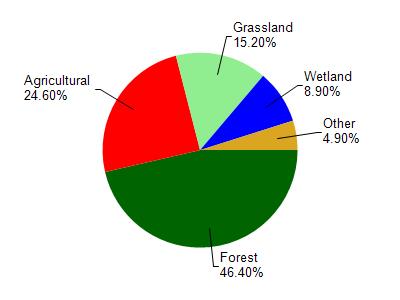Richland
No
No
No
Fish and Aquatic Life
Overview
Smith Lake is an oxbow lake located adjacent to Cruson Slough on the Wisconsin River flood plain near Lone Rock. The lake is fed by seepage and springs and is unique in loving a 100 percent sand bottom and exceptionally clear water. Although spring flow is sufficient to keep a portion of the lake from freezing, and several springs are located in the lake, the vater warms considerably in summer. A good population of largemouth bass and bluegills provide a sport fishery. Northern pike and crappies are also present. A large population of carp, forage species, and bowfin is also present but does not create a major use problem. Productive wetland totaling 437 acres adjoins the lake, of which 60 percent is shrub swamp, 20 percent is timber swamp, and 20 percent is deep marsh. The lake lies entirely within a public hunting area. Muskrats, mink, and otter are present, and waterfowl are common to abundant during spring and fall. Deer are also common in the area. Access is provided by a sand road along the shore and an unimproved ramp is present where small boats may be launched.
Source:1970, Surface Water Resources of Richland County,WI:WI-DNR Smith Lake; T8N, R2E, Sec. 11 Surface area = 17 acres, S.D.F. = 3.65, maximum depth = 5 ft.
Date 1970
Author Aquatic Biologist
Condition
Wisconsin has over 84,000 miles of streams, 15,000 lakes and milllions of acres of wetlands. Assessing the condition of this vast amount of water is challenging. The state's water monitoring program uses a media-based, cross-program approach to analyze water condition. An updated monitoring strategy (2015-2020) is now available. Compliance with Clean Water Act fishable, swimmable standards are located in the Executive Summary of Water Condition in 2018. See also the 'monitoring and projects' tab.
Reports
Management Goals
Wisconsin's Water Quality Standards provide qualitative and quantitative goals for waters that are protective of Fishable, Swimmable conditions [Learn more]. Waters that do not meet water quality standards are considered impaired and restoration actions are planned and carried out until the water is once again fishable and swimmable
Management goals can include creation or implementation of a Total Maximum Daily Load analysis, a Nine Key Element Plan, or other restoration work, education and outreach and more. If specific recommendations exist for this water, they will be displayed below online.
Monitoring
Monitoring the condition of a river, stream, or lake includes gathering physical, chemical, biological, and habitat data. Comprehensive studies often gather all these parameters in great detail, while lighter assessment events will involve sampling physical, chemical and biological data such as macroinvertebrates. Aquatic macroinvertebrates and fish communities integrate watershed or catchment condition, providing great insight into overall ecosystem health. Chemical and habitat parameters tell researchers more about human induced problems including contaminated runoff, point source dischargers, or habitat issues that foster or limit the potential of aquatic communities to thrive in a given area. Wisconsin's Water Monitoring Strategy was recenty updated.
Grants and Management Projects
| Project Name (Click for Details) | Year Started |
|---|
|
|
Monitoring Projects
| WBIC | Official Waterbody Name | Station ID | Station Name | Earliest Fieldwork Date | Latest Fieldwork Date | View Station | View Data |
|---|
| 1236400 | Smith Lake | 10019774 | Smith Slough -- Lone Rock Unit #2 | 6/22/2012 | 9/20/2023 | Map | Data |
| 1236400 | Smith Lake | 10036939 | Smith Lake | 6/22/2010 | 10/31/2025 | Map | Data |
|

Watershed Characteristics
Smith Lake is located in the Bear Creek watershed which is 136.54 mi². Land use in the watershed is primarily forest (46.40%), agricultural (24.60%) and a mix of grassland (15.20%) and other uses (13.80%). This watershed has 236.07 stream miles, 119.46 lake acres and 6,798.61 wetland acres.
Nonpoint Source Characteristics
This watershed is ranked Medium for runoff impacts on streams, Not Ranked for runoff impacts on lakes and High for runoff impacts on groundwater and therefore has an overall rank of High. This value can be used in ranking the watershed or individual waterbodies for grant funding under state and county programs.However, all waters are affected by diffuse pollutant sources regardless of initial water quality. Applications for specific runoff projects under state or county grant programs may be pursued. For more information, go to surface water program grants.